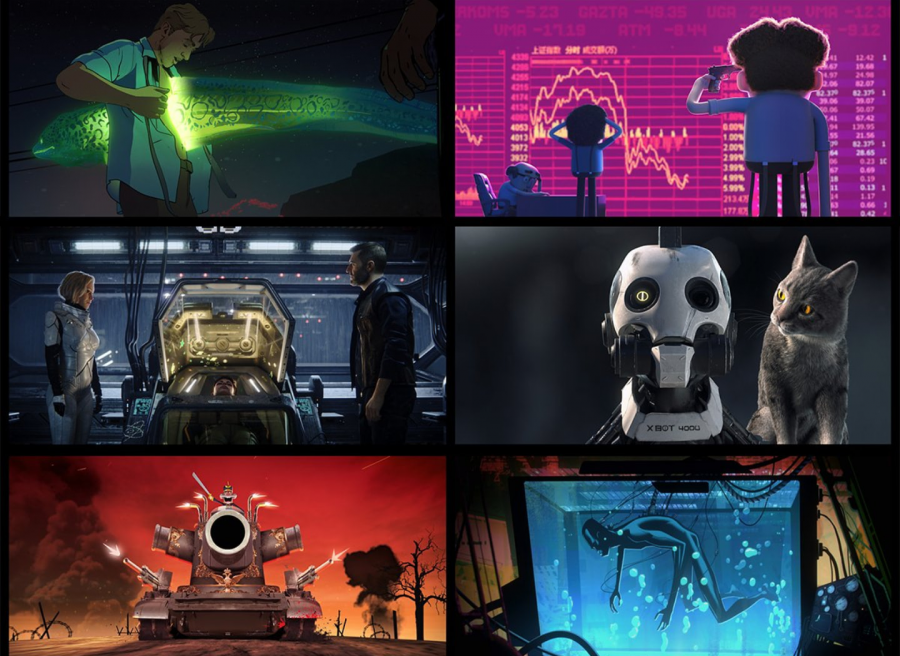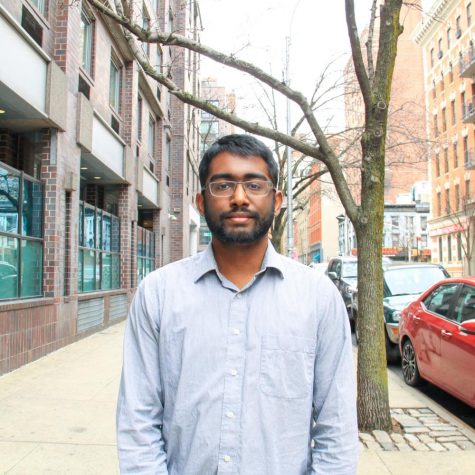David Fincher helped bring Netflix’s popularity to new heights with the critically acclaimed “House of Cards,” one of the streaming service’s first big hits. He came back with a strong and innovative season one for the series “Mindhunter,” and is once again pushing streaming’s boundaries with the bizarre “Love, Death & Robots” anthology series. Co-executive produced by creator Tim Miller, the director of “Deadpool,” the series is an ambitious and mostly satisfying package of animated shorts that sometimes explore themes of sexuality and female oppression and are occasionally just plain and fun action set pieces.
The series consists of 18 shorts, ranging between six and 17 minutes, each thematically tied to the show’s title. All but two of the episodes are based on short stories. Episodes also experiment with animation style: some use CGI graphics, some are hand-drawn and one is a live-action-animation hybrid.
While there is an obvious “Black Mirror” comparison to be made, “Love, Death & Robots” does not completely lean into social commentary as the other sci-fi anthology series do. Episodes like “Suits,” in which farmers operating mech suits fight invading aliens, and “Blindspot,” a story about cyborgs trying to complete a heist, are unabashedly fun romps that deliver on heart, character and levity. “Suits” in particular stands out because of its well thought-out action sequences and the strong family dynamic that it maintains as its emotional core. “Blindspot” is short, but its animation is joyfully reminiscent of an old ’90s cartoon with the tone of “Ben 10.”
There are also more serious episodes that explicitly deal with rape and brutality against women. “Sonnie’s Edge” focuses on a woman who participates in underground gladiatorial battles by remotely controlling genetically engineered monsters. The titular character is revealed to be a rape victim and the episode explores how she copes with her trauma through the battles and her relationship with the monsters. It is uncompromising, it is gory and it has a killer twist that packs a punch, but still feels like a mature way of grappling with a weighty theme.
The more nuanced “Good Hunting,” an anime-style episode, explores the relationship between Liang and Yan, a female spirit called a huli jing that people believe seduce and kill men. After Liang’s father kills Yan’s mother, the two of them befriend one another. The episode uses a smart mix of folklore and sci-fi to comment on moving away from dying traditions — Liang grows to be an inventor in steampunk Hong Kong, so he literally adapts with the world around him and gives up his father’s rigid perception of huli jings — and discrimination against women. Yan’s ultimate revenge against the world becomes driven by the men who have abused her, believing they can do anything and get away with it. She spends much of the episode in hiding: Liang’s father dies not knowing about their friendship. When she becomes a sex worker, she only comes out at night, and when she has been turned into a cyborg, she comes to Liang in a thick trench coat, refusing to let the outside world see her. But with Liang’s help, Yan transforms into a new being altogether and unleashes herself into the night to prey on abusive men. The episode is one of the best written and directed in the show, and one of the few that warrant multiple watches.
Despite some of these more progressive episodes, there are some that are glaringly gratuitous. Interestingly, the two episodes that are most guilty of this are pretty similar in structure: “Beyond the Aquila Rift” and “The Witness.” The former deals with a space crew that lands at a discreet space station after going off course for an unknown reason, while the latter deals with a stripper who witnesses a murder and is chased down by the murderer. Both episodes are visually stunning — “The Witness” feels like a deliberately messier and darker version of “Spider-Man: Into the Spider-Verse” — but feature unnecessary nudity that seems to be there for the sake of showing off animated breasts and sex scenes. Unfortunately, neither episode overcomes its own plot contrivances. Each of them ends with the revelation that the character is in a tragically existential endless loop of events — the space captain, especially, is tragic as he will never find a way home, but he’ll never realize this truth completely in his world.
What rounds out the rest of “Love, Death & Robots” is a bunch of absurd and funny episodes that don’t really amount to anything — they are neither action packed nor thought provoking. “Alternate Histories,” which shows six different ways of how Adolf Hitler could have died, or “Helping Hand,” a “Gravity” rip-off about an astronaut who drifts from her space station and floats around, are some of the more forgettable episodes. The strangest of them all is “When the Yogurt Took Over” which is — you guessed it — a six-minute narrated piece about a cup of yogurt that takes over the world and builds a seemingly perfect society for humans to live under.
As the episodes range so much in tone and presentation, there is no cohesive theme that runs through all of them. Some delve heavily into either the love, death or robot part of the title, or a combination of some sort, but as a whole, they do not all feel like a connected package.
The show is one of the most notable projects to have graced the streaming platform and although it is an imperfect product, Netflix and the show’s creators should certainly be applauded for their lofty ambitions. While not every episode is a home run, each has some merit that warrants a watch, whether it’s the animation style, the action, dialogue or themes being explored. Besides, if it ever feels like too much work to watch “Black Mirror,” “Love, Death & Robots” is a much faster — and less emotionally draining — binge.
Email Guru Ramanathan at [email protected].
























































































































































